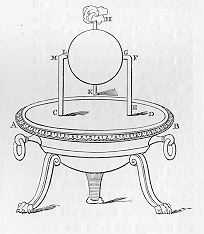The Steam-Engine described by Hero of Alexandria
 | “A fire is lighted under a cauldron, A B, (fig. 50), containing water, and covered at the mouth by the lid C D; with this the bent tube E F G communicates, the extremity of the tube being fitted into a hollow ball, H K. Opposite to the extremity G place a pivot, L M, resting on the lid C D; and let the ball contain two bent pipes, communicating with it at the opposite extremities of a diameter, and bent in opposite directions, the bends being at right angles and across the lines F G, L M. As the cauldron gets hot it will be found that the steam, entering the ball through E F G, passes out through the bent tubes towards the lid, and causes the ball to revolve, as in the case of the dancing figures.” |
| Graphic representation of Hero’s Engine ~200–0 BCE |
As to the dating of this the Translator of Hero’s work makes the following observation:
Clinton, (F. H. vol. iii. pp. 535, 538,) who puts Hero as low down as the end of the second century B.C., proceeds on the following evidence : Athenaeus (vol. iv. p. 174, edit. Schweighaeuser) quotes one Aristocles as saying, in a work {GREEK}, of the water-organ, {GREEK}. Now Euergetes II (Ptolemy VII.) reigned from B.C. 170 to B.C. 117, and hence Clinton assigns Hero, the pupil of Ctesibius, to the reign of Ptolemy VIII. that is, to B. C. 117–81… [this set of dates] assigned by Clinton has been generally adopted1 For more on this consult the source at http://www.history.rochester.edu/steam/hero/translators.html.
1 The Pneumatics of Hero of Alexandria, Translated for and Edited by Bennet Woodcraft, Taylor Walton and Maberly, London, 1851, Translator’s Preface, http://www.history.rochester.edu/steam/hero/translators.html (viewed 25 Jan 2012) (↑)
Pages linked to this page
 This work by Jim Falk is licensed under a Creative Commons Attribution-NonCommercial-NoDerivs 3.0 Unported License Click on the logo to the left to see the terms on which you can use it.
This work by Jim Falk is licensed under a Creative Commons Attribution-NonCommercial-NoDerivs 3.0 Unported License Click on the logo to the left to see the terms on which you can use it.